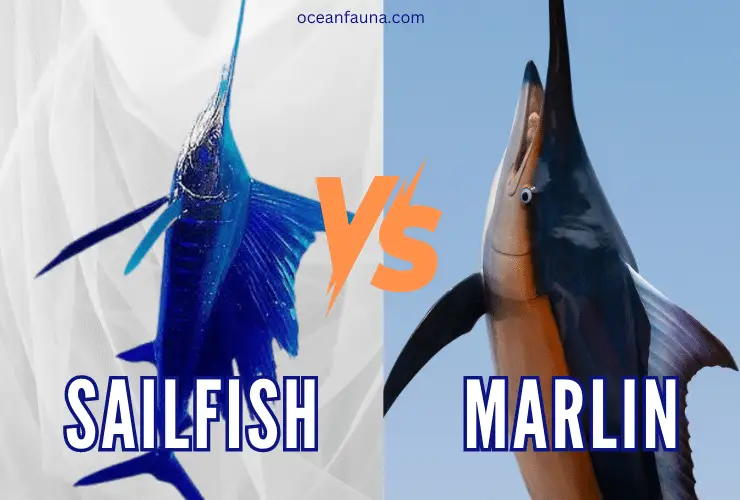Sailfish and marlin are two popular fish that may appear as twins at first glance. They do, however, have some differences.
One notable difference is the unique sail-like structure on the dorsal fin of sailfish. This feature is absent in marlins, which have a smaller dorsal fin that doesn’t extend as much. Plus, sailfish have spots on their bodies and stripes on their fins, while marlin are usually just one color with some faint stripes on their bodies.

But these fish are much more than just their outward features. Did you knowsailfish are faster than marlin? They can swim at speeds of 68 miles per hour, while marlin can reach up to 50 mph. Sailfish use their speed to chase their prey, while marlin rely on their strength and stamina.
Size is another way these fish are different. Sailfish are usually smaller than marlin – about 9 feet long. In comparison, marlins can grow up to a whopping 14 feet long!
So, sailfish and marlin may belong to the same family. They are different species.
Read on to learn more about what makes sailfish and marlin unique. We promise you won’t be disappointed! There’s a whole ocean of differences to explore.
Sailfish Vs Marlin – A Quick Comparison
Let’s take a quick look at their differences.
| Parameters | Sailfish | Marlin |
| Genus | Istiophorus | Makaira |
| Habitat | Upper layer in Atlantic, Indian, and Pacific Oceans | Deeper waters in Atlantic, Indian, and Pacific Oceans |
| Speed | 68 mph | 50 mph (*Black marlin 80 mph) |
| Shape | Slender | Cylindrical |
| Length | 9 ft | 14 ft |
| Weight | 221 lb | 1560 lb |
| Snout | Long pointed. | Long pointed but thicker and more rounded |
| Dorsal Fin | Large sail-like dorsal fin | Long-sloping dorsal fin |
| Pelvic Fins | Present | Absent |
| Color | Blue or gray | Dark blue or black |
| Lifespan | up to 15 years | up to 27 years |
Sailfish Vs Marlin: What Are the Key Differences?
Sailfish and marlin often get mixed up as they belong to the same Billfish family. Both have long, spear-like upper jaws. They are also both highly migratory, traveling long distances across the oceans in search of food and mates. They are both fast, powerful, and majestic predators that can reach impressive sizes and put up a great fight for anglers.
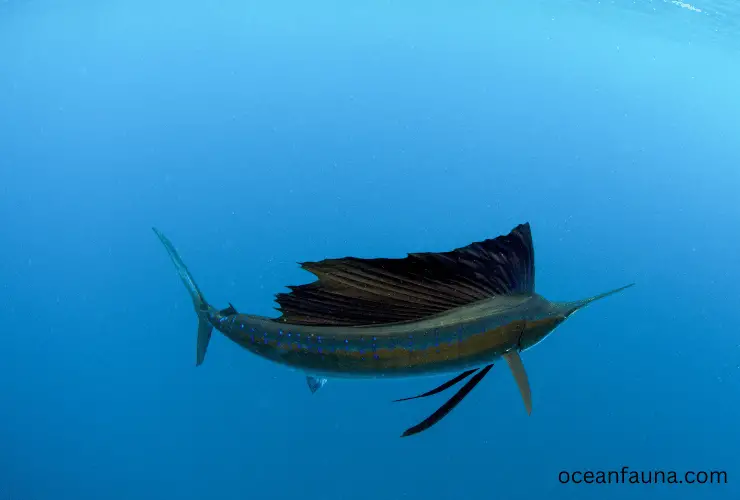
But don’t get it twisted! We’ll highlight some clear differences between sailfish and marlin that will help you tell them apart. Let’s look closer and see who’s who in the undersea zoo!
1. Scientific Classification
Taxonomically, both these fish belong to the same family Istiophoridae. They are both classified under the order Perciformes, which includes a diverse group of bony fish. But they are from different genera.
Sailfish
Sailfish belongs to the genus Istiophorus. They have two main subspecies:
- Atlantic sailfish (Istiophorus albicans)
- Indo-Pacific sailfish (Istiophorus platypterus).
Some scientists consider them a single species, while others recognize them as distinct based on their size, color, and DNA.
Marlin
Marlin belongs to the genus Makaira. They have four main species:
- Blue marlin (Makaira nigricans),
- Black marlin (Istiompax indica),
- Striped marlin (Kajikia audax),
- White marlin (Kajikia albida).
These species are distinguished by their color, shape, size, and distribution.
| Classification | Sailfish | Marlin |
| Family | Istiophoridae | Istiophoridae |
| Order | Perciformes | Perciformes |
| Genus | Istiophorus | Makaira |
2. Habitat and Distribution
Sailfish and marlin are both oceanic fish inhabiting warm waters around the world. But they have different habitat preferences.
Sailfish
Sailfish live in tropical and subtropical waters, including the Atlantic, Indian, and Pacific Oceans. These fish prefer to hang out near the top of the water, where the water is warmer than 70 °F. But they can go as deep as 1,150 feet below the surface to find their meals.
Marlin
Marlin lives in similar warm waters, but they prefer deeper depths. They are often found near underwater structures like seamounts and underwater canyons. They prefer the upper 200-300 feet of the water column. However, they can dive up to 1,500 feet to find food.
| Feature | Sailfish | Marlin |
| Preferred Habitat | Upper layers | Deeper waters |
| Maximum Depth | 1150 ft | 1500 ft |
3. Physical Appearance
Sailfish and marlin might share some similarities in their looks, but they have some features that make them unique.
Sailfish
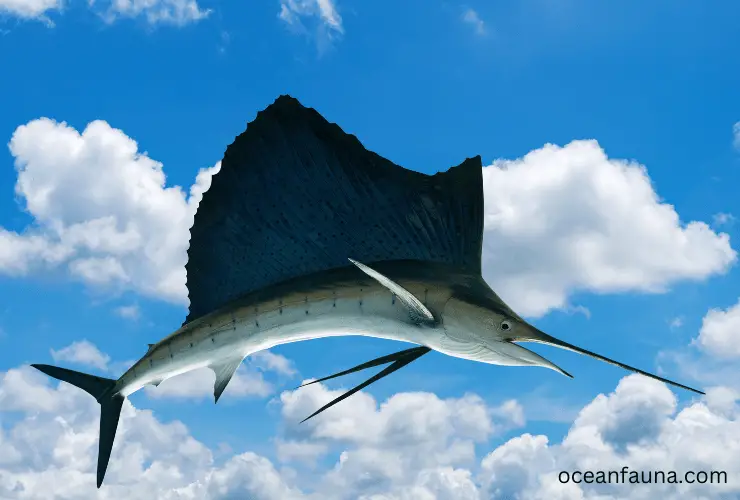
1. Body shape: Sailfish have a slender body.
2. Dorsal fin: They have a large dorsal fin that covers almost their entire body length. This fin is extendable and can be raised or lowered at will. When raised, it becomes wider than their body, resembling a sail.
3, Pelvic fins: They also have pelvic fins that can be extended sideways, like wings.
4. Anal and Pectoral fins: They have two anal fins and two pectoral fins that are pointed and can be folded against the body. Their tail fin is deeply forked and has a crescent shape.
5. Bill: They have a long, pointed bill or snout to stun their prey before capturing it with their sharp teeth.
6. Coloration: They have a blue back with a silver belly. They have about 20 vertical bars on their sides that can change color from light blue to dark purple. The sail is usually blue or purple with black spots and stripes.
Marlin
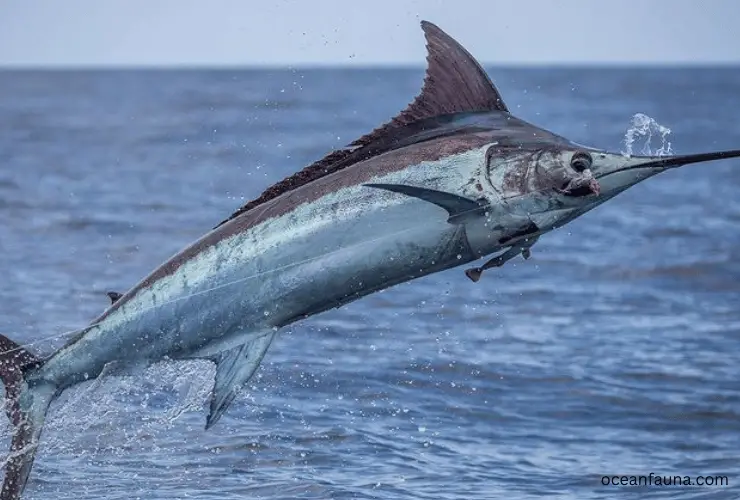
1. Body shape: Marlin resembles sailfish but has a more robust, cylindrical body with tapered ends.
2. Dorsal fin: Marlin has a smaller dorsal fin and is more rigid than the sail of a sailfish. The dorsal fin is not extendable and stays close to the body. It is usually dark blue or black with white spots or stripes.
3. Pelvic fins: Marlin does not have pelvic fins that can be extended sideways like wings.
4. Anal and tail fin: Marlins have two anal fins covering almost the entire body length. Their tail fin is also deeply forked but has a more pointed shape.
5. Bill: Marlin also has a long, pointed bill or snout, but it is thicker and more rounded than a sailfish.
6. Coloration: Marlin has different colors depending on the species.
- Black marlin have a black back and a silver-white belly, with no stripes on their sides.
- Striped marlin have a light blue back and a silver-white belly, with dark blue vertical stripes on their sides.
- Blue marlin has a dark blue back and a silver-white belly, with light blue vertical stripes on its sides.
- White marlin have a light blue back and a silver-white belly, with faint brown spots on their sides.
| Feature | Sailfish | Marlin |
| Body | Slender | Cylindrical |
| Dorsal fin | Larger | Smaller |
| Pelvic fin | ✓ | Absent |
| Tail fin | Crescent shape | More pointed |
| Bill | Long pointed. | Long pointed but thicker and more rounded |
| Coloration | Blue or gray back; silver sides and belly | Dark blue or black back; silver or white belly. |
4. Size and Weight
Sailfish and marlin are among the ocean’s biggest fish. However, marlin is generally larger and heavier than sailfish.
Sailfish
The average size of a sailfish is about 8 feet long and 120 pounds in weight. The largest sailfish ever recorded was 11 feet long and 221 pounds.
Marlin
A marlin typically measures 11 feet long and weighs 400 pounds. The largest marlin ever captured measured 16 feet long and weighed 1,560 pounds.
| Feature | Sailfish | Marlin |
| Length | 6 to 11 ft | Up to 16 ft |
| Weight | 221 lb | 1560 lb |
5. Speed and Swimming Abilities
Sailfish and marlin are both fast swimmers. They have a swim bladder, which helps them adjust their buoyancy and depth. Yet, they both differ in their speed and swimming abilities.
Sailfish
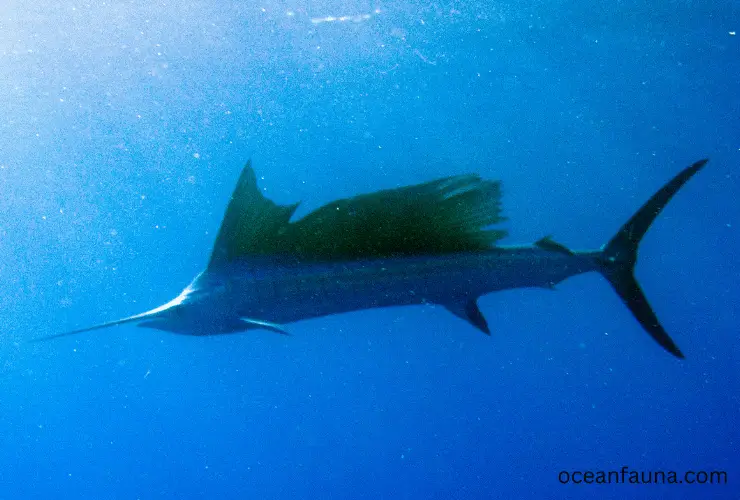
Sailfish have a large dorsal fin, which helps them swim faster. While swimming, they use their sail to increase lift and decrease drag.
When the sailfish is hunting or escaping from predators, it can raise its sail to create more surface area and increase its speed. It can lower its sail to reduce drag and save energy when resting or cruising.
They can reach speeds of up to 68 miles per hour. They can also leap out of the water and perform acrobatic maneuvers in the air.
Did you know? Sailfish also use their sails to communicate with other sailfish, signal their mood, or intimidate their prey or predators.
Marlin
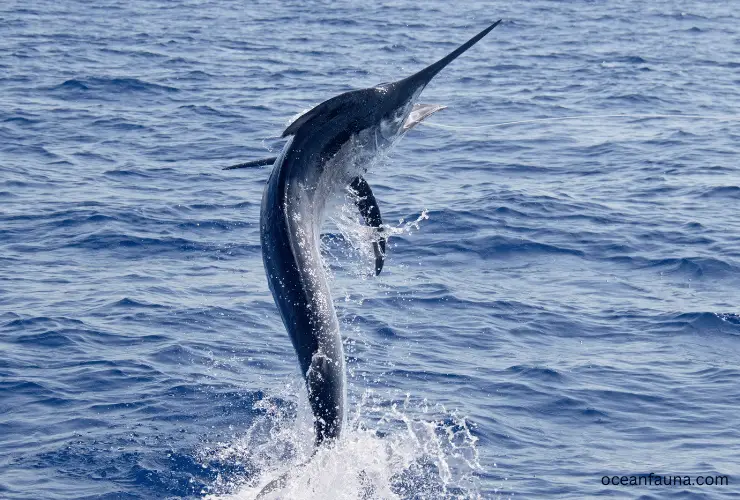
Marlin does not have a sail. But they have another adaptation that helps them swim faster: a rigid pectoral fin that can be locked in place or folded against the body.
When the marlin is hunting or escaping from predators, it can lock its pectoral fin to create more stability and maneuverability. It can fold its pectoral fin when resting or cruising to reduce drag and save energy.
Marlins are also fast swimmers, but not as fast as sailfish. They can swim at 50 miles per hour. However, there’s an exception- the black marlin can swim at 80 mph, being the fastest fish in the ocean. They use their dorsal fin to stabilize themselves while swimming.
Fun fact: Marlin can swim long distances without tiring. They can also jump out of the water and shake their heads violently to free themselves from hooks or nets.
| Aspect | Sailfish | Marlin |
| Top Speed | 68 mph | 50 mph (*Black marlin 80 mph) |
| Swimming technique | Large dorsal fin | Rigid pectoral fin |
6. Diet and Feeding Habits
Both sailfish and marlin are carnivorous fish that mainly eat smaller fish, such as sardines, anchovies, mackerel, tuna, dorado, and flying fish. They also enjoy squid, octopus, crustaceans, and occasionally sea turtles or seabirds. Both are active predators that feed primarily during the day. However, they use different hunting strategies to catch their prey.
Sailfish
Sailfish usually hunt in groups or schools, using their speed and agility to chase and surround their prey. They also use their sails to herd or confuse their prey into tight groups, making them easier to catch. They then use their bills to slash or stun their prey before swallowing them whole.
Marlins
Marlins usually hunt alone or in pairs. They are known for their powerful strikes, which they use to subdue their prey quickly. They also use their bills to spear or impale their prey before shaking them off or biting them into pieces with their sharp teeth.
7. Reproduction and Lifecycle
Sailfish and marlin have similar reproductive and lifecycle patterns. They are both oviparous and reproduce by external fertilization.
They release millions of eggs and sperm into the water, where they mix and fertilize to form an embryo. The embryos then develop into larvae that drift with the ocean currents until they grow into juveniles that can swim independently.
Sailfish
Sailfish have a shorter lifespan than marlin. They can live for almost 15 years in the wild, reaching sexual maturity at around 2 to 3 years of age. They spawn several times a year, producing around 4 million eggs per spawning event.
Marlin
Marlins have a longer lifespan than sailfish, living for almost 27 years in the wild. They reach sexual maturity at around 3 to 5 years of age. They spawn once or twice a year, producing up to 7 million eggs per event.
| Aspect | Sailfish | Marlin |
| Sexual Maturity | 2 to 3 years | 3 to 5 years |
| Eggs per spawning event | ~ 4 million eggs | ~7 million eggs |
| Average Lifespan | ~ 15 years | ~ 27 years |
8. Sailfish and Marlin: Are They Edible?
Sailfish and marlin are both edible. But they are not very tasty or nutritious. They have a high mercury and low-fat content, making them dry and bland. Most anglers practice catch-and-release when fishing for these fish, as they are more valued for their sport than their meat.
Sailfish
Sailfish have dark red, oily meat with a strong flavor that is not appealing to most people. It is sometimes smoked or made into jerky, but it is not very popular as a food source.
Marlin
Marlin meat is lighter in color with a milder flavor than sailfish. It is sometimes sold as steaks or fillets in markets or restaurants but is less desirable. However, some people do enjoy eating marlin, especially in certain cuisines such as Hawaiian or Japanese.
| Meat | Sailfish | Marlin |
| Taste | Strong | Milder |
| Color | Dark red and oily | Lighter color |
9. Threats and Conservation Status
Both sailfish and marlin face many threats in their natural habitats. They travel long distances crossing international boundaries. So, they’re difficult to protect.
Sailfish
The IUCN has ranked sailfish as “Vulnerable” on the Red List of Threatened Species. This means that they face a high risk of extinction in the wild in the near future. Their population has reduced by over 50% in the past 75 years due to overexploitation and habitat loss.
Marlin
Depending on the species, Marlin is classified as either “Vulnerable” or “Endangered” by the IUCN. All four species of marlin have undergone substantial population declines due to overfishing and bycatch.
| Species | Conservation Status |
| Sailfish | Vulnerable |
| Marlin | Vulnerable or Endangered |
How Important Are Sailfish and Marlin to the Ecosystem?
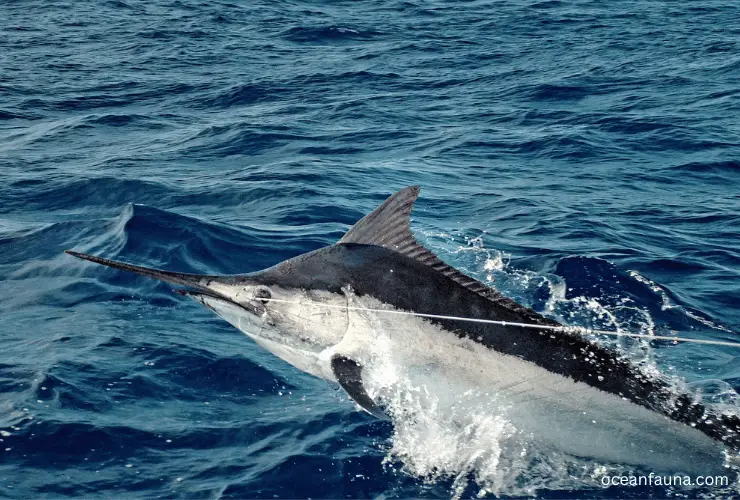
- Sailfish and marlin are top predators that regulate the balance of prey populations.
- They also provide food for sharks, dolphins, and seabirds.
- They are important to the economy, attracting millions of dollars from recreational fishing tourism.
- They generate revenue from commercial fishing, although this is less sustainable and more environmentally harmful.
- They are culturally significant to many coastal communities with associated traditions and legends.
Sailfish Vs Marlin: Who Would Win?
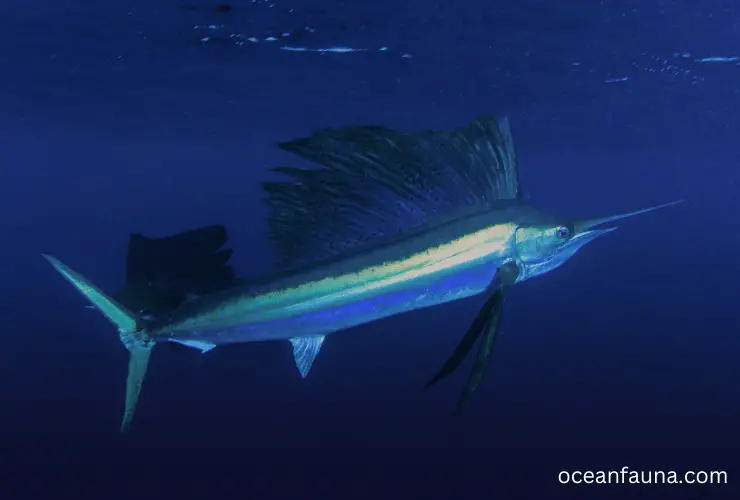
Sailfish and marlin are the ocean’s fastest and most powerful fish. But who would win in a fight between these two magnificent creatures?
A sailfish might have an edge in speed and agility. But a marlin might win in power and stamina. A sailfish might use its fin to confuse or distract a marlin. But a marlin might use its bill to inflict serious damage on a sailfish. A sailfish might avoid conflict with a larger and stronger marlin. But a marlin might pursue a smaller and weaker sailfish.
Generally, they prefer to respect each other’s territory and swim in opposite directions. But, if they do happen to engage in a tussle, it would be one epic show to witness!
FAQs
Who Hunt Sailfish and Marlins?
Sailfish and marlin are both apex predators in their marine ecosystems and do not have many natural predators. However, some larger marine animals may prey on them, especially when they are young or vulnerable. They are commonly eaten by sharks, killer whales, swordfish, and humans.
Is a marlin faster than a sailfish?
The black marlin is faster than a sailfish, with a speed of 80 mph. But all other species of marlins are slower than the sailfish, which has a speed of 68 mph.
Can you eat sailfish?
Yes, you can eat sailfish. But they are not considered good food.
Do sailfish eat other fish?
Yes, sailfish eat other fish.
Finalizing
So, Are Sailfish and Marlin the Same? No! Even though they might look similar and share the title of ocean apex predators, sailfish and marlin are not the same.
They are both members of the Billfish family, but they come from different genera. Sailfish is from the genus Istiophorus and have long, slender bodies and large, sail-like dorsal fin. Conversely, Marlin is from the genus Makaira, having long, pointed bills and muscular bodies.
Their unique similarities and differences make them like the ultimate game of spot-the-difference! We hope you’ve enjoyed learning all these fascinating differences between these amazing creatures of the sea!

